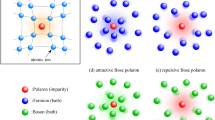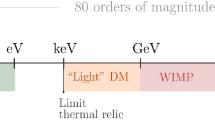Abstract
Emergence of superheavy nuclei and hypernuclei, two fields of intense research in nuclear physics, has made a big impact on the nuclear chart; while the discovery of the superheavy oganesson has completed the seven full rows of the periodic table, discovery of several exotic hypernuclei have added a third dimension, called strangeness, to the existing nuclear chart. Highlights of some recent developments in these two fields are presented


Similar content being viewed by others
References
Nilsson SG, Nix JR, Sobiczewski A, Szymaski Z, Wycech S, Gustafson C, Mller P (1968) On the spontaneous fission of nuclei with Z near 114 and N near 184. Nucl Phys A 115:545
Mosel U, Greiner W (1968) Investigation of the collective potential-energy-surface. Z Phys 217:256
Nilsson SG et al (1969) On the nuclear structure and stability of heavy and superheavy elements. Nucl Phys A 131:1
Fiset EO, Nix JR (1972) Calculation of half-lives for superheavy nuclei. Nucl Phys A 193:647
Mnzenberg G, Armbruster P, Folger H, Hessberger FP, Hofmann S, Keller J, Poppensieker K, Reisdorf W, Schmidt K-H, Schtt H-J, Leino ME, Hingman R (1984) The identification of element 108. Z Phys A Atoms Nucl 317:235
Patyk Z, Sobiczewski A, Armbruster P, Schmidt KH (1989) Shell effects in the properties of the heaviest nuclei. Nucl Phys A 491:267
Moller P, Nix JR (1994) Stability of heavy and superheavy elements. J Phys G Nucl Phys 20:1681
Armbruster P (2003) On the production of superheavy elements. Acta Phys Pol B 34:1825
Hofmann S et al (1995) Production and decay of 269110. Z Phys A 350:277
Hofmann S et al (2007) The reaction 48Ca + 238U 286112 studied at the GSI-SHIP. Eur Phys J A 32:251
Morita K et al (2004) Experiment on the synthesis of element 113 in the reaction 209Bi (70Zn, n) 278113. J Phys Soc Jpn 73:2593
Morita K et al (2007) Observation of second decay chain from 278113. J Phys Soc Jpn 76:045001
Hamilton H, Hofmann S, Oganessian YT (2013) Search for superheavy nuclei. Ann Rev Nucl Sci 63:383
Oganessian YT, Utyonkov VK (2015) Super-heavy element research. Rep Prog Phys 78:036301
Ćwiok S, Heenen P-H, Nazarewicz W (2005) Shape coexistence and triaxiality in the superheavy nuclei. Nature 433:705
Bender M, Nazarewicz W, Reinhard P-G (2001) Shell stabilization of super-and hyperheavy nuclei without magic gaps. Phys Lett B 515:42
Samanta C, Roy ChowdhuryP, Basu DN (2007) Predictions of alpha decay half lives of heavy and superheavy elements. Nucl Phys A 789:142
Samanta C, Basu DN, Roy ChowdhuryP (2007) Quantum tunneling in 277112 and its alpha-decay chain. J Phys Soc Jpn 76:124201
Roy ChowdhuryP, Basu DN, Samanta C (2007) Alpha decay chains from element 113. Phys Rev C 75:047306
Roy ChowdhuryP, Samanta C, Basu DN (2008) Search for long lived heaviest nuclei beyond the valley of stability. Phys Rev C 77:044603
Roy ChowdhuryP, Samanta C, Basu DN (2008) Nuclear lifetimes for alpha radioactivity of elements with 100 ≤ Z ≤ 130. Nucl Data At Data Tables 94:781
Roy ChowdhuryP, Samanta C, Basu DN (2006) α decay half-lives of new superheavy elements. Phys Rev C 73:014612
Oganessian Yu, Ts UtyonkovVK, Lobanov YuV, Sh AbdullinF, Polyakov AN, Sagaidak RN, Shirokovsky IV, Tsyganov YuS et al (2006) Synthesis of the isotopes of elements 118 and 116 in the 249Cf and 245Cm + 48Ca fusion reactions. Phys Rev C 74:044602
Royer G, Gherghescu RA (2002) On the formation and alpha decay of superheavy elements. Nucl Phys A 699:479
Myers WD, Swiatecki WJ (1996) Nuclear properties according to the Thomas–Fermi model. Nucl Phys A 601:141
Muntian I, Patyk Z, Sobiczewski A (2001) Sensitivity of calculated properties of superheavy nuclei to various changes. Acta Phys Pol B 32:691
Muntian I, Hofmann S, Patyk Z, Sobiczewski A (2003) Fission properties of super-heavy nuclei. Acta Phys Pol B 34:2073
Muntian I, Hofmann S, Patyk Z, Sobiczewski A (2003) Properties of heaviest nuclei. Acta Phys Pol B 34:2073
Sobiczewski A, Patyk Z, Ćwiok S (1989) Deformed superheavy nuclei. Phys Lett B 224:1
Hoffman DC, Lee DM, Pershina V (2006) Transactinides and the future elements. In: Morss E, Norman M, Fuger J (eds) The chemistry of the actinide and transactinide elements, 3rd ed. Springer, Dordrecht. ISBN 1-4020-3555-1
Hopper D, Biswas S (1950) Evidence concerning the existence of the new unstable elementary neutral particle. Phys Rev 80:1099
Danysz M, Pniewski J (1953) Delayed disintegration of a heavy nuclear fragment: I. Philos Mag 44:348
Akira Ohnishi, Kenji Morita, Takenori Furumoto (2017) Lambda–Lambda interaction from two-particle intensity correlation in relativistic heavy-ion collisions. JPS Conf Proc 17:031003
Tang L et al (2014) Experiments with high resolution kaon spectrometer at JLab Hall C and the new spectroscopy of \(\begin{array}{*{20}c} {12} \\ \varLambda \\ \end{array} {\text{B}}\) hypernuclei. Phys Rev C 90:034320
Gogami T et al (2016) Spectroscopy of the neutron-rich hypernucleus \(\begin{array}{*{20}c} 7 \\ \varLambda \\ \end{array} {\text{He}}\) from electron scattering. Phys Rev 94:021302(R)
Gogami T et al (2016) High resolution spectroscopy study of \(\begin{array}{*{20}c} {10} \\ \varLambda \\ \end{array} {\text{Be}}\). Phys Rev C93:034314
Nakazawa K et al (2015) Study of double-strangeness nuclear systems with nuclear emulsion. Phys Procedia 80:69
Nakazawa K et al (2014) Progress on the study of double-Lambda hypernuclei. J Phys Conf 569:012082
Nakazawa K (2010) for KEK-E176, E373 and J-pane E07, Double Λ hypernuclei via the Ξ-hyperon capture at rest reactions in a hybrid emulsion. Nucl Phys A 835:207
Davis DH (2005) 50 years of hypernuclear physics: I. The early experiments. Nucl Phys A 754:3
Hasegawa T et al (1996) Spectroscopic study of 10B, 12C, 28Si, 89Y, 139La and 208Pb by the (π + , K +) reaction. Phys Rev C 53:1210
Bodmer AR, Usmani QN (1985) Coulomb effects and charge symmetry breaking for the A = 4 hypernuclei. Phys Rev C 31:1400
Bando H, Motoba T, Zofka J (1990) Production, structure and decay of hypernuclei. Int J Mod Phys A 5:4021
Miller GA, Opper AK, Stepenson EJ (2006) Charge symmetry breaking and QCD. Ann Rev Nucl Sci 56:253
Gal A, Millener DJ (2011) Shell model predictions for Lambda–Lambda hypernuclei. Phys Lett B 701:342
Gal A (2015) Charge symmetry breaking in Λ hypernuclei revisited. Phys Lett B 744:352
Achenbach P (2017) Charge symmetry breaking in light hypernuclei. Few-Body Syst 58(1):17
Botta E, Bressani T, Feliciello A (2017) On the binding energy and the charge symmetry breaking in A ≤ 16Λ-hypernuclei. Nucl Phys A 960:165
Hiyama Emiko and Nakazawa Kazuma (2018) Structure of S = 2 hypernuclei and hyperon–hyperon interactions. Annu Rev Nucl Sci 68:131
Schmitt TA, Samanta C (2018) A-dependence of Λ–Λ-bond and charge symmetry energies. EPJ Web Conf 182:03012
Samanta C (2018) Superheavy nuclei to hypernuclei: a tribute to Walter Greiner. EPJ Web Conf 182:02107
Samanta C (2010) Genaralized mass formula for non-strange, strange, and multiply strange nuclear systems. J Phys G 37:075104
Samanta C, Roy ChaudhuryP, Basu DN (2008) Lambda hyperonic effect on the normal driplines. J Phys G 35:065101
Samanta C, Roy ChaudhuryP, Basu DN (2006) Genaralized mass formula for non-strange and hypernuclei with SU(6) symmetry breaking. J Phys G 32:363
Hu JN, Li A, Shen H, Toki H (2014) Quark mean field model for single and double lambda hypernuclei. Prog Theor Exp Phys 2014:013D02
Gal A, Hungerford EV, Millener DJ (2016) Strangeness in nuclear physics. Rev Mod Phys 88:035004
Feliciello A, Nagae T (2015) Experimental review of hypernuclear physics: recent achievements and future perspectives. Rep Prog Phys 78:096301
Bogdan Povh (1987) Nuclear physics with strange particles. Prog Nucl Phys 18:183
Botvina AS, Pochodzalla J (2007) Production of hypernuclei in multifragmentation of nuclear spectator matter. Phys Rev C 76:024909
Samanta C, Schmitt TA Binding, bonding and charge symmetry breaking in Λ hypernuclei. AIP Conf Proc (in press); arXiv:1710.08036v2 [nucl-th]
Buyukcizmeci N, Botvina AS, Pochodzalla J, Bleicher M (2013) Mechanisms for the production of hypernuclei beyond the neutron and proton drip lines. Phys Rev C 88:014611
Buyukcizmeci N, Botvina AS, Ogul R (2018) Investigation of binding energies of lambda hypernuclei. Nucl Theory 37:155
Hayano RS, Ishikawa T, Iwasaki M, Outa H, Takada E, Tamura H, Sakaguchi A, Aoki M, Yamazaki T (1989) Observation of a bound state of 4He (Σ) hyper-nucleus. Phys Lett B 231:355
Owen Chamberlain, Emilio Segré, Clyde Wiegand, Thomas Ypsilantis (1955) Observation of antiprotons. Phys Rev 100:947
Bruce Cork, Lambertson Glen R, Oreste Piccioni, Wenzel William A (1956) Antineutrons produced from antiprotons in charge-exchange collisions. Phys Rev 104:1193
Antipov YM et al (1974) Observation of antihelium 3. Yad Fiz 12:311 (in Russian)
Collaboration STAR (2011) Observation of the antimatter helium-4 nucleus. Nature 473:353
Ma YG, Chen JH, Xue L (2012) A brief review of antimatter production. Front Phys 7:637. arXiv:1301.4902v1 [nucl-ex]
The STAR Collaboration (2010) Observation of an antimatter hypernucleus. Science 328:58
Collaboration ALICE (2015) Precision measurement of the mass difference between light nuclei and anti-nuclei. Nat Phys 11:811
ALICE Collaboration (2016) 3 ΛH and \(\begin{array}{*{20}c} 3 \\ \bar \Lambda\\ \end{array} \bar H\) production in Pb-Pb collisions at \(\surd (S_{NN} ) = \, 2.76\) TeV. Phys Lett B 754:360
Acknowledgements
The author would like to thank the Virginia Military Institute for the support.
Author information
Authors and Affiliations
Corresponding author
Additional information
Publisher's Note
Springer Nature remains neutral with regard to jurisdictional claims in published maps and institutional affiliations.
Rights and permissions
About this article
Cite this article
Samanta, C. Superheavy nuclei and hypernuclei: extending the limits of the nuclear chart. J Radioanal Nucl Chem 322, 205–211 (2019). https://doi.org/10.1007/s10967-019-06677-5
Received:
Published:
Issue Date:
DOI: https://doi.org/10.1007/s10967-019-06677-5




